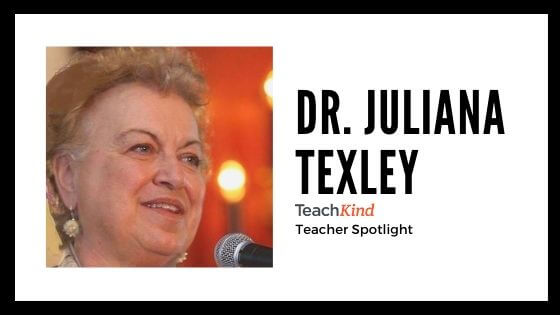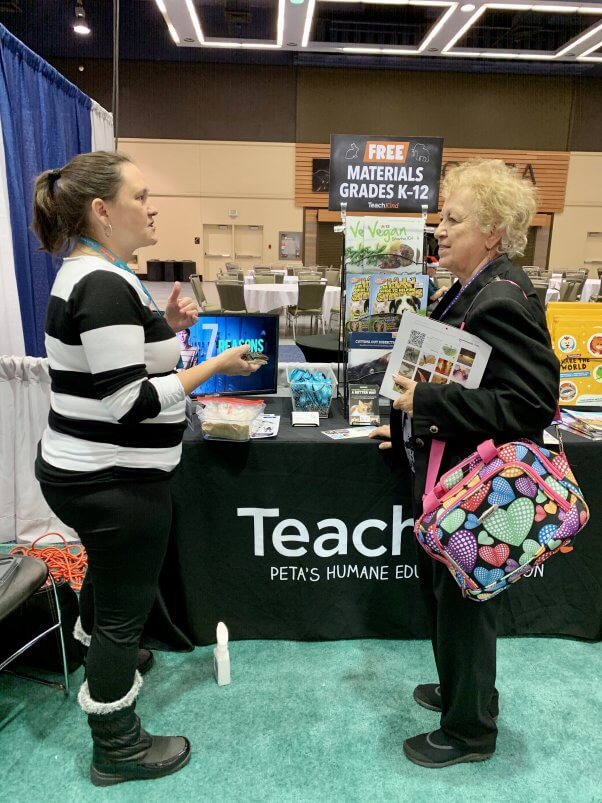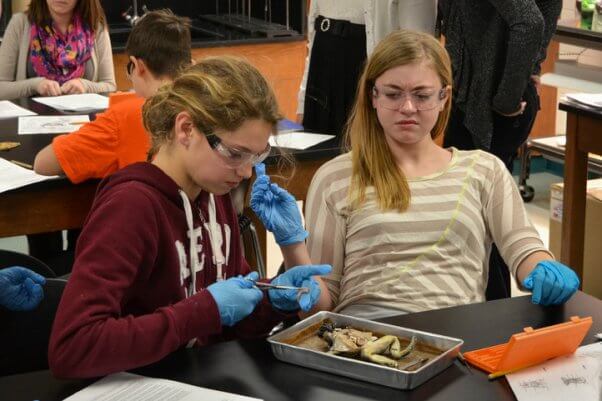Teacher Spotlight: Meet Dr. Juliana Texley
The Teacher Spotlight highlights the work of various humane educators, giving them a chance to share their stories and tips and inspire other compassionate teachers like you to take action for animals through education.
TeachKind staff had the pleasure of meeting Dr. Juliana Texley, former president of the National Science Teaching Association (NSTA)—”the largest professional organization in the world promoting excellence and innovation in science teaching and learning for all”—at the organization’s 2019 area conference in Seattle. Dr. Texley has taught all areas of science, technology, engineering, and mathematics (STEM) education and every grade level from kindergarten through graduate school (“except second grade,” she notes), having spent much of her career working both in and out of the classroom to replace animal dissection. She now strives to influence the NSTA’s current committee chair to change the organization’s policy on using animals in the classroom.

Dr. Texley’s accolades are numerous and wide-ranging. She taught middle school and high school science for more than 20 years in Richmond, Michigan, before serving as assistant superintendent in the Anchor Bay School District for two years and then superintendent there for seven years. She has taught at Lesley University, Palm Beach State College, and Central Michigan University. And she’s also worked with various stakeholder groups on the Next Generation Science Standards (NGSS) to develop a curriculum for JASON Learning, a program for middle school learners “designed to motivate and inspire students to pursue interests and careers in science, technology, engineering and mathematics.”
Dr. Texley was kind enough to answer a few questions for TeachKind about her experiences as a leader in science education, how she teaches compassion and reverence for animals within the context of STEM, and where she sees the field of science heading in years to come.
*****
How does compassion for animals fit into a high school science curriculum?
Compassion springs from mutual respect. New Zealand has moved to recognize all animals as sentient beings. The more we know about animals, the more we realize how complex they are.
For decades (in the last century), there was a real reluctance to include the study of animal behavior in school curricula. Even NSTA had a total prohibition in its award program against books that portrayed anthropomorphic behaviors in animals. A great deal of this came from a reluctance to face the many sad ways in which animals were mistreated.
NGSS includes behavior as a core content area of life science. This will naturally lead to greater understanding and compassion.

When and how did you discover that dissecting animals is an ineffective teaching strategy?
Well, let’s begin by admitting that it’s nothing but rote memorization in almost every case. NGSS talks about teaching the relationship between structure and function, but dissection is almost never taught that way. In terms of what we call “constructivist” (inquiry) learning, it’s pretty worthless.
But more importantly, I believe it diminishes our respect for sensitive living beings. If students knew about the “frog factories” and other places where their specimens were produced, they’d be shocked. The problem is that most teachers today don’t know the methods by which natural behaviors can be studied through quantitative observation. (Of course, I say this with great caution—you must be able to ensure that an animal is safe and comfortable in order to make these observations. Classroom cages can’t allow for that. It might be possible with web cams, nature centers, or animal companions.)
Dissection has an “ick” factor. That emotional response really blocks most of the potential for logic in the experience. Teachers think that they’re succeeding because the kids do go home and tell their parents what they did. But they virtually never learn good science from the experience. (Naming parts is not a practice of science.)

What challenges, if any, do you face as a former NSTA president when discussing the issues of animal dissection and modernizing classroom practices?
We want much more laboratory science to occur. There are two main problems: First, the textbooks don’t change quickly, and second, teachers don’t have a repertoire of really exciting life science experiences to share beyond dissection. We need a new “Sputnik-style” professional development revolution in life science education.
How do you go about educating students using humane science activities instead of animals?
I have many, many lab activities I share that don’t involve dissection or inappropriate captivity of animals. Some involve botany, some are observational natural history, and some use the newer biotechnologies. All are low in cost.
I teach quantitative observational methods and biostatistics. Real biology is highly mathematical and uses the practices of science.
What advice would you give to brand-new science teachers?
I teach a grad class for teachers who already have their certificate. I’m amazed, often, that their preparation really hasn’t included much cutting-edge science. I’d advise them to force themselves to stay current and not depend on textbooks for knowledge.
What advice would you give to science teachers who are stuck in the cycle of dissecting animals?
I’d give them new labs and experiences that are much more exciting. I’d tell them to try these things—they’d like them a lot more than dissection.
Where do you see science education heading in the next 20 years?
Well, I’ve been reviewing a new book on biology from an impressive author. I will use it, as it really shakes up the sorts of assumptions and old standards that today’s biology teachers learned. We would talk about the so-called “central dogma of biology”: DNA makes RNA makes enzymes. That isn’t central or true in all cases any more. We talk about species but now realize that this system is just a convenient way to organize what we see and that it doesn’t reflect nature much at all.
In 20 years, we will have sequenced a cell from Mars. That will change everything. If the “code” is the same, it means one thing. If it’s totally different—wow. Every book will be rewritten.
In the meantime, we need to forget about subject-area boundaries and relate everything we do to the goal of becoming better human beings.
*****
There are many modern, humane alternatives to animal dissection, but one that we’re really excited about is SynFrog—a lifelike, anatomically correct, reusable synthetic frog that can be cut into just as students would cut into a real frog. The SynFrog is uniquely positioned to help prevent millions of frogs from being killed for classroom dissection worldwide, and you can be a part of this progress!





